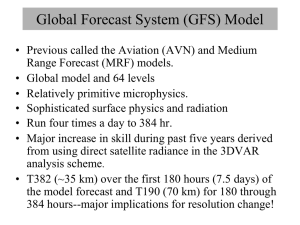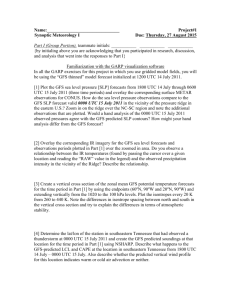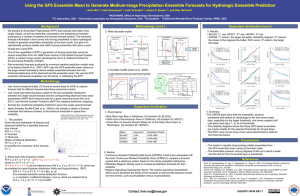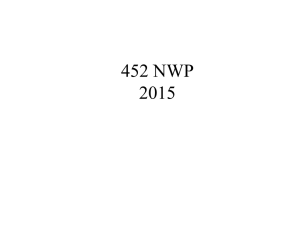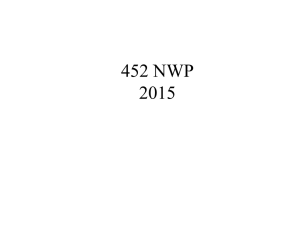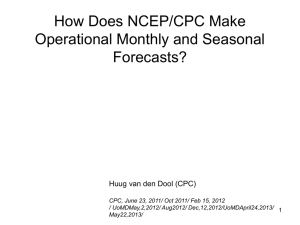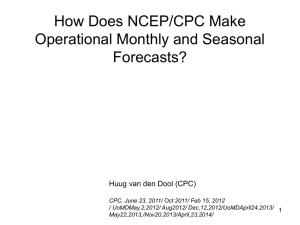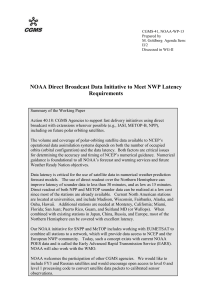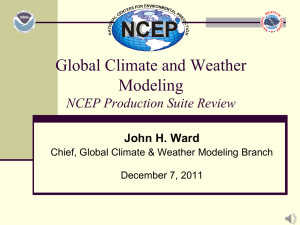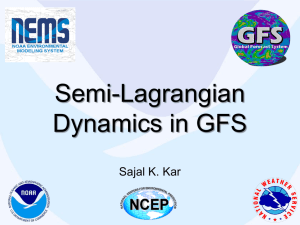emc.overview.for SA-NWP - Met e
advertisement
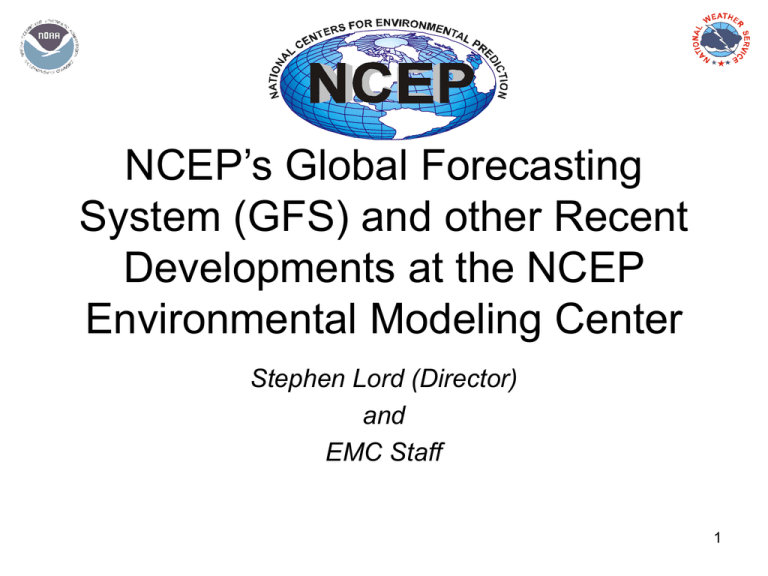
NCEP’s Global Forecasting
System (GFS) and other Recent
Developments at the NCEP
Environmental Modeling Center
Stephen Lord (Director)
and
EMC Staff
1
2
Currently being upgraded again - major changes to allow easier upgrades in future
3
Overview
•
•
•
•
•
•
Global weather
NASA-NOAA-DOD JCSDA
Climate
Mesoscale weather
Ocean
Hurricanes
4
Global Weather
• Global Forecast System (GFS)
• Global Ensemble Forecast System (GEFS)
– Extended T126 horizontal resolution after 180 hours
– Initial perturbations (breeding cycle):
• Fixed bugs for calculating re-scaling factors
• Use 6-h breeding instead of 24-h breeding
• Adjust mask to tune initial perturbation
– Tropical storm relocation
• Add TS relocation scheme to ensemble initial perturbation
(5% of total storm size).
5
Global Forecast System (GFS) model Configuration
GFS
Spectral
Sigma
T382/L64
(0-180 h)
T190/L64
(180-364 h)
Global
GFS
Simple Cloud
Modified Arakawa/
Schubert
GFS
Chou (SW), GFDL (LW)
Ferrier
JCSDA SST
NESDIS/USAF
NOAH Land Model
6-Layer Model
Burk and Thompson
6
GFS - List of Upgrades
• Global Forecasgt System (GFS)
– Increase resolution from T254 (55 km) to T382 (35 km)
• Old: T254/L64 (0-84 h) T170/L42 (84-180h, T126/L28 to 384h
• New: T382/L64 (0-180 h) T190/L64 (180-364 h)
– Modified vertical diffusion
– Enhanced mountain blocking
– New sea ice model
• Fractional sea ice & leads
• Impacts surface fluxes
– New code structure
• Increased computational efficiency
• ESMF compatible superstructure
• “Hybrid (sigma-pressure) ready”
7
GFS - List of Upgrades (cont)
• Model (cont)
– Upgrade to Noah Land Surface Model
• 2-4 soil layers
• Reduction of early bias in snow pack depletion
• Improved treatment of
– Frozen soil
– Ground heat flux
– Energy and water balance at surface
• Reformulated infiltration and runoff functions
• Upgraded vegetation fraction (NESDIS)
• Improved, plug-compatible, code structure
8
GFS - List of Upgrades (cont)
• Analysis
– 3D-VAR
– Increase resolution to T382
– Surface emissivity model for snow and ice (JCSDA)
• 3 X data used in SH polar latitudes
• 1.3 X in NH polar latitudes
–
–
–
–
AQUA AIRS and AMSU-A (new data)
AIRS (new data)
Upgraded thinning algorithm for radiances
QC algorithm for clouds
9
Performance Results - Winter
AC +2%
RMS - 8%
Consistent
day-to-day
performance
10
Performance Results –
Summer
AC +3%
RMS - 8%
Consistent
day-to-day
performance
11
Global Weather
• Global Forecast System (GFS)
• Global Ensemble Forecast System (GEFS)
– Extended T126 horizontal resolution after 180 hours
– Initial perturbations (breeding cycle):
• Fixed bugs for calculating re-scaling factors
• Use 6-h breeding instead of 24-h breeding
• Adjust mask to tune initial perturbation
– Tropical storm relocation
• Add TS relocation scheme to ensemble initial perturbation
(5% of total storm size).
12
Increasing spread for
week-two forecast
Deterministic
Runs
Ensemble
Runs
Black-opr
Red-exp
13
SH RMS
and spread
Improved outlier
SH ROC
SH RPSS
Improved skill for short,
extended-range forecast
14
Hurricane Track Plots (case 1)
Frances (08/28)
With relocation
Without relocation
15
Track errors and spreads
2004 Atlantic Basin (8/23-10/1)
opr-errors
400
exp-errors
opr-spread
exp-spread
From Timothy Marchok (GFDL)
350
300
250
200
150
100
Reduced mean track
errors and spreads
50
0
24h
48h
72h
96h
120h
16
Overview
•
•
•
•
•
•
Global weather
NASA-NOAA-DOD JCSDA
Climate
Mesoscale weather
Ocean
Hurricanes
17
NCEP Data Assimilation system is moving form
Spectral Statistical Interpolation (SSI)
to
Grid-point Statistical Interpolation (GSI)
Continuing with 3D-VAR for now,
due to product delivery timetable constraints
NCEP Global Forecast System must begin delivering products
to users within
about 3 hours of radiosonde observations
Also doing tests with alternative forms of 4D-VAR
18
Monthly Mean TBges-TBobs
AMSU-A1&A2 NOAA15
A1
A2
A3
A5
New
A1
A2
current
19
GPSRO Data Assimilation Development (L. Cucurull)
• Current and short-term work:
– Implementation of the local Bending Angle Forward
Operator (BAFO) in the GSI.
– Examination of representativeness error.
• If realistic errors (for refractivity and bending angle
along the vertical) are not available in time for
impact studies, we will use simulated errors.
– Compare impact studies between BAFO and RFO
and select the Forward Operator for COSMIC.
– Develop (real-time) Monitoring System (O-B) for
calibrating/testing the RO
20
Assimilation of RO + other data
RO locations
22
Getting COSMIC data to Weather Centers
NCEP
I
n
p
u
t
D
a
t
a
C
D
A
A
C
BUFR Files
WMO standard
1 file / sounding
N
E
S
D
I
S
ECMWF
GTS
CWB
UKMO
JMA
Canada Met.
This system is currently under development by UCAR, NESDIS, & UKMO
23
New JCSDA SATELLITE SST Retrieval
Method:
• Developed as alternative SST retrieval method
– based on a physical retrieval (variational) algorithm which runs
within the structure of the GDAS (Derber and Xu Li).
– Cost function minimizes the increment between;
• Observed radiances and simulated radiances, and
• Analyzed SST and its first guess
• Requires radiative transfer model to simulate Brightness
Temperatures for each channel using
– SST first guess (previous analysis)
– Air Temperature (GDAS analysis)
– Water vapor mixing ratio (GDAS analysis)
24
Smoother anomalies
(less noise)
Smoother anomalies
(less noise)
25
Daily Analysis Difference
RTG_SST-HR
Operational
Reduced daily noise
26
Data Assimilation Status
•
Gridpoint Statistical Analysis (GSI)
– NCEP’s next generation system
• Evolutionary combination of the global SSI analysis system and the regional ETA
3DVAR
• Application to both global and regional analysis
• Strong heritage to satellite, radar, profiler, surface data
– Background error defined in grid space instead of spectral space
• Allows use of situation dependent background errors
• Will accept ensemble information
– Improved balance condition
• Adiabatic dynamics model
• Capable of simplified 4-D Var
– Improved and modernized code
• F90/95 structures and utilities
• Increased scalability of code
• Efficiency
– Redesigned data distribution
– Some OpenMP
• Better documentation
• Less dependency on IBM
– Community support intended but not resourced
• Currently 15 registered groups (46 users) using GSI code
• NASA/GMAO major group using code and to date they have provided the most
updates from external users
27
Overview
•
•
•
•
•
•
Global weather
NASA-NOAA-DOD JCSDA
Climate
Mesoscale weather
Ocean
Hurricanes
28
NCEP Performance Comparison
Seasonal Forecasts
Raw Nino3.4 SST Correlation Skill
Annual Mean 1981-2001
NCEP CFS
wrt OIv2 1971-2000 climatology
100
CA (Statistical)
CFS
ECM
MFR
DEMETER
Anomaly Correlation [ % ]
80
60
MPI
UKM
ING
40
LOD
CER
CA
20
0
1
2
3
Forecast Lead [ months ]
4
5
29
Overview
•
•
•
•
•
•
Global weather
NASA-NOAA-DOD JCSDA
Climate
Mesoscale weather
Ocean
Hurricanes
34
Katrina
Multi-model Consensus
CONU:
GFS
UKMO
NGPS
GFDL
GFDN
35
36
Examples of GFS performance
Compared with:
1 - Other Global models
2 - NCEP’s North American Mesoscale models
37
Human forecaster
{
GFS
Ensembles
38
Precipitation Forecast
Comparisons (Threat & Bias)
Model groups
International (1)*
Period
10/2004 – 9/2005
Forecast
f24-f48
North American+
10/2004 – 9/2005
f24-f48
North American
International (2)*
International (2)*
North American
10/2004 – 9/2005
10/2004 – 6/2005
7/2005 – 9/2005
7/2005 – 9/2005
f24
f24-f72
f24-f72
f24-f48
* International global (1): DWD, ECMWF, JMA, UK, USA
International global (2): CMC, DWD, ECMWF, JMA, USA
+ North American: USA (global), USA (NAM), CMC (global), CMC (regional)
39
Precipitation Verification at NCEP/EMC
Precipitation forecasts from various operational and parallel (experimental)
models are verified over ConUS and its 14 sub-regions:
• Daily (12Z-12Z) verification against daily gauge analysis (7,000-8,000 gauges)
• 3-hourly verification against NCEP Stage II multi-sensor hourly analysis
• Verification for international models for 24 h accumulated amounts over
ConUS domain
Statistics on the number of
forecast/correctly forecast/observed
forecast points (FHO) are collected for
various precipitation thresholds. Dozens
of scores can be computed from the FHO
database, e.g. equitable threat, bias,
probability of detection, odds ratio.
40
Global Models – Annual
1 October 2004 – 30 September 2005
24 – 48 h Forecasts
41
Global Models – Cold season
1 October 2004 – 30 June 2005
24 – 72 h Forecasts
42
Global Models – Warm season
1 July 2005 – 30 September 2005
24 – 72 h Forecasts
43
North American Models - Annual
1 October 2004 – 30 September 2005
24 – 48 h Forecasts
44
North American Models – Warm season
1 July 2005 – 30 September 2005
24 -48 h Forecasts
45
All operational data available on web without any restrictions for use
46
